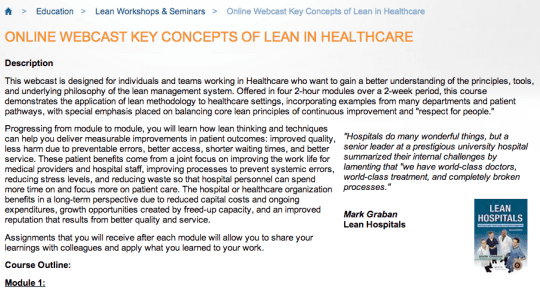Today's guest post is by Duke Rohe, a Quality Improvement Education Consultant at M.D. Anderson Cancer Center in Houston, Texas. I know Duke from his ongoing involvement with the Society for Health Systems. Check out his previous guest post on Kaizen (continuous improvement).
Kaizen Success Factors
- Create a receptive environment for ideas – It starts with the manager then cascades to the staff. No one is above generating improvements and no one is without the ability to make improvement.
- Address every idea received with importance. It's important to its contributor. Take the time to help the contributor develop it or to realize it's not do-able.
- Create a system of consistent reception, feedback, nurturing, cost justifying, recognition, broadcasting, and deployment.
- Encourage, even fight for the little idea. Idea is the life of change. It honors the person who generated it and it sends a message of value to all who are watching.
- Develop an expectation for idea generation. Try one a month per employee. Proclaim a war on waste. Every problem that arises is great material for an idea.
- Remove barriers which impede implementation. Get petty cash, outside assistance, approvals… whatever you can to make implementation a down-hill slide.
- Keep the idea initiator apprised of idea status once it's submitted. Time and lack of communication work against the generation of future idea.
- Require initiator to evaluate the total cost, including other areas impacted, and to derive the time value or potential savings from the idea.
- Implement the idea (which turns it into an innovation) with clarity to all who encounter it. If possible, integrate needed instruction at the point of the innovation's use.
- Broadcast the knowledge of the innovation to all who need to know of its introduction. Brag on its initiator. Take a before and after picture. Get others to apply it in their area if appropriate.
- Sustain it. Catalogue your innovations to remind you of where you've come from and to keep check to see if it is still enforced and useful.
Learn more about the upcoming SHS conference next month. I'm sure Duke will be there, as usual. I'll be presenting, as will be my Healthcare Kaizen co-author, Joe Swartz. Hope to see you there, it's a great event.
 Don't forget my reader book raffle, where I'm giving away a copy of one of my books to one winner. Read more and enter the contest here.
Don't forget my reader book raffle, where I'm giving away a copy of one of my books to one winner. Read more and enter the contest here.
LEI online Lean Healthcare class reminder:
The Lean Enterprise Institute has been experimenting with online webinar-based education (including a class by my friend Dan Markovitz). I'm happy to be doing an online “Key Concepts of Lean in Healthcare” class with them this February. I'll be teaching the class in four 2-hour segments across two weeks, with homework to be done in between the classes. Click here or on the image below to learn more and to sign up.
What do you think? Please scroll down (or click) to post a comment. Or please share the post with your thoughts on LinkedIn – and follow me or connect with me there.
Did you like this post? Make sure you don't miss a post or podcast — Subscribe to get notified about posts via email daily or weekly.
Check out my latest book, The Mistakes That Make Us: Cultivating a Culture of Learning and Innovation:












I love the work Duke and his colleagues are doing at M.D. Anderson.
I have just a few comments on the tips. If there’s no comment on a tip, it’s because I think it’s completely awesome as is.
3: Not every Kaizen can or should be “cost justified.” That’s what Mr. Imai teaches in his “Kaizen” book (Norm Bodek, as well) and I think it’s reasonable, practical advice. At my co-author’s organization, they only have a hard cost savings for about 10% of their Kaizens, but they end up saving tons of money because the Kaizens that don’t have a cost justification (because they are good for safety or the patient experience, for example) lead to better morale and more Kaizen participation – which then can possibly save money. Sometimes managers can, however, coach staff to figure out the cost savings and ROI when it *can* be calculated (but it doesn’t always have to be there).
4: Yes, the little ideas might not have “cost justification” and we should fight for them anyway.
5: The only caution is to not let “1 Kaizen per ____” become a hard quota that must be met no matter what. We want to encourage intrinsic motivation for Kaizen.
8: I’d say “help” instead of “require.” If there’s a measurable cost savings (or revenue boost), then great.
Very important points from Duke!!!
1. Top management needs to show solid support for Kaizen, for every employee to embrace the Kaizen Culture. Culture trickles down from management and improvements made bottom up. Management needs to go to the gemba and see what hardships or problems employees face day in and day out. Everyone is part of the company’s team and communication, collaboration and respect is key.